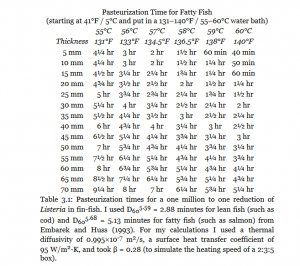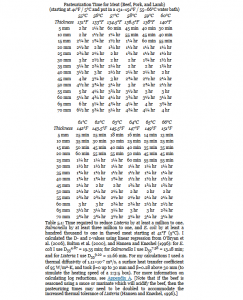This segment of Baldwin's tutorial goes a long way in explaining stuff....
1. Food Safety
Non-technical Summary
You cook food to make it safe and tasty. Sous vide cooking is no different: you just have more control over both taste and safety. In sous vide cooking, you pick the temperature that equals the doneness you want and then you cook it until it’s safe and has the right texture.
Raw food often has millions of microorganisms on or in it; most of these microorganisms are spoilage or beneficial bacteria and won’t make you sick. But some of these microorganisms are pathogens that can make you sick if you eat too many of them. Most food pathogens are bacteria, but some are viruses, funguses, and parasites. Your yogurt, aged cheese, and cured salami can have hundreds of millions of spoilage or beneficial bacteria in every serving; but they don’t make you sick because spoilage and beneficial bacteria are distinct from pathogens. Since pathogens don’t spoil food, you can’t see, smell, or taste them.
While there are many ways to kill food pathogens, cooking is the easiest. Every food pathogen has a temperature that it can’t grow above and a temperature it can’t grow below. They start to die above the temperature that they stop growing at and the higher above this temperature you go, the faster they die. Most food pathogens grow fastest a few degrees below the temperature that they start to die. Most food pathogens stop growing by 122°F (50°C), but the common food pathogen
Clostridium perfringens can grow at up to 126.1°F (52.3°C). So in sous vide cooking, you usually cook at 130°F (54.4°C) or higher. (You could cook your food at slightly lower temperatures, but it would take you a lot longer to kill the food pathogens.)
While there are a lot of different food pathogens that can make you sick, you only need to worry about killing the toughest and most dangerous. The three food pathogens you should worry about when cooking sous vide are the
Salmonella species,
Listeria monocytogenes, and the pathogenic strains of
Escherichia coli.
Listeria is the hardest to kill but it takes fewer
Salmonella or
E. coli bacteria to make you sick. Since you don’t know how many pathogens are in your food, most experts recommend that you cook your food to reduce:
Listeria by at least a million to one;
Salmonella by ten million to one; and
E. coli by a hundred thousand to one. You can easily do this when you cook sous vide: you just keep your food in a 130°F (54.4°C) or hotter water bath until enough bacteria have been killed.
How long does it take for you to reduce, say,
Listeria by a million to one? Your water bath temperature is very important: when cooking beef, it’ll take you four times longer at 130°F (54.4°C) as it does at 140°F (60°C). What you are cooking is also important: at 140°F (60°C), it’ll take you about 60% longer for chicken as it does for beef. Other things, like salt and fat content, also affect how long it takes; but these difference are small compared with temperature and species.
Since sous vide cooking in a water bath is very consistent, I’ve calculated the worst-case cooking times so you don’t have to. My worst-case cooking times are based on the temperature, thickness, and type of the food and will give at least a million to one reduction in
Listeria, a ten million to one reduction in
Salmonella, and a hundred thousand to one reduction in
E. coli:
- Table 3.1 has the pasteurization times for fish;
- Table 4.1 has the pasteurization times for poultry; and
- Table 5.1 has the pasteurization times for meat (beef, pork, and lamb).
Thick pieces of food, like a rib-roast, take much longer to cook and cool than thin pieces of food: a steak that is twice as thick takes about four times longer to cook and cool! So unless you are cooking a rib-roast for a party, you should cut your food into individual portions that can be cooled quickly and easily. It’s important that your pouches of food do not crowd or overlap each other in your water bath and are completely under the water; otherwise my tables will underestimate the cooking time.
If you’re not going to eat all your food immediately, then you need to know that some bacteria are able to make spores. Spores themselves will not make you sick, but they can become active bacteria that could. Cooking to kill active bacteria like
Listeria,
Salmonella, and
E. coli will leave these spores unharmed. If you keep your food hot, then the spores will not become active bacteria. But when you cool your food, the spores can become active bacteria: if you cool your food too slowly or store it for too long, then these active bacteria can multiply and make you sick. To keep these spores from becoming active bacteria, you must quickly cool your food – still sealed in its pouch – in ice water that is at least half ice until it’s cold all the way through. You can then store your food in your refrigerator for a few days or freeze it for up to a year.
Table 1.1 has approximate cooling times in ice water based on thickness and shape.
If you want to learn more about food safety, please continue reading below; see my book
Sous Vide for the Home Cook;
the excellent free guide by Dr Snyder;
the FDA’s food safety website; or your local health and human services department.















